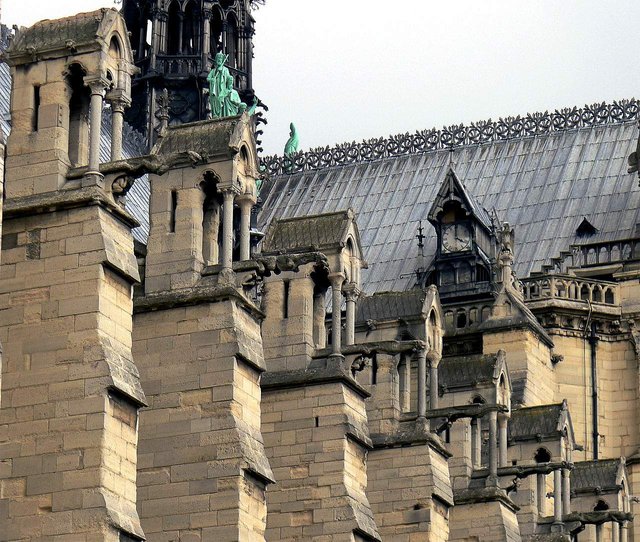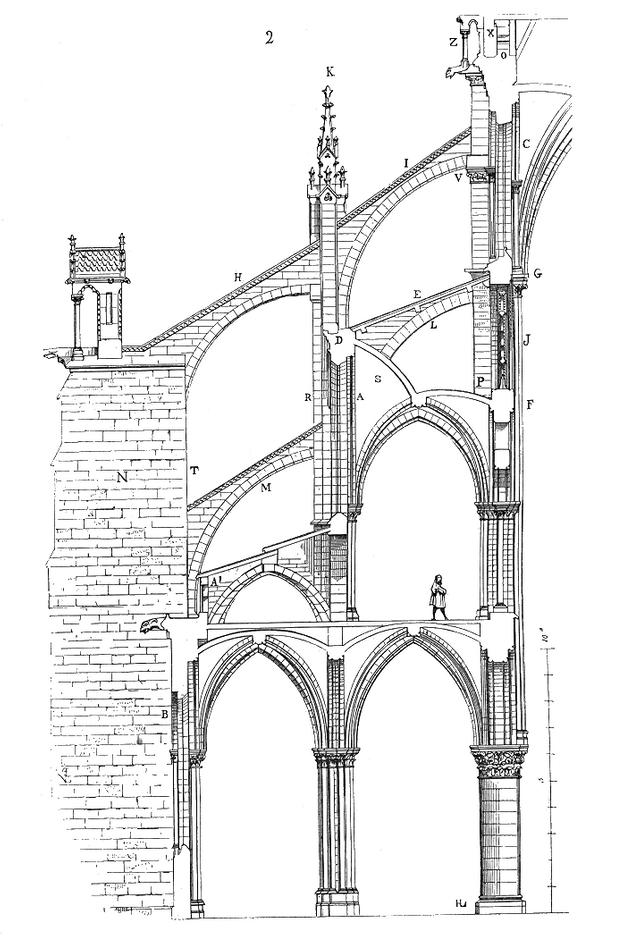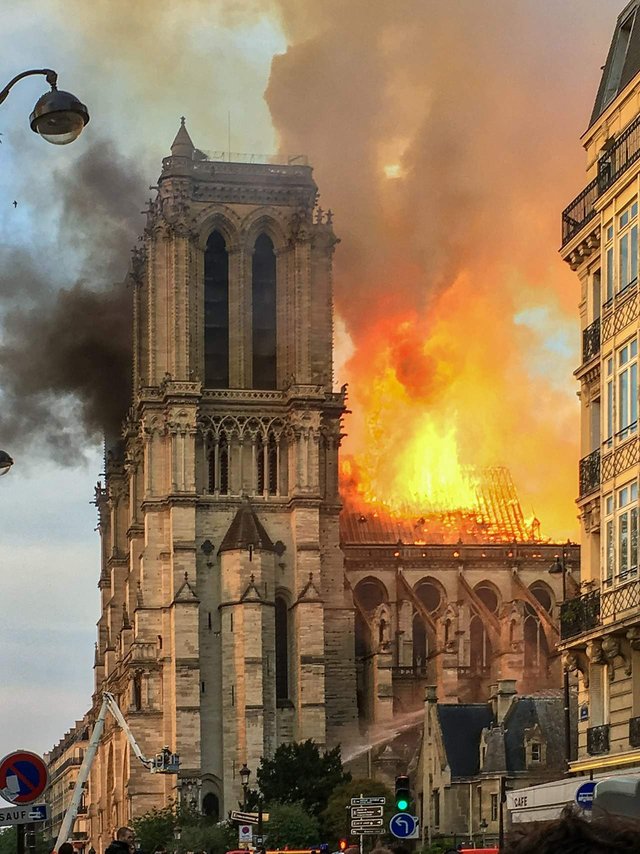history of cathédrale notre-dame de paris
The cathedral was begun in 1160 under Bishop Maurice de Sully and was largely complete by 1260, though it was modified frequently in the following centuries. In the 1790s, Notre-Dame suffered desecrationduring the French Revolution; much of its religious imagery was damaged or destroyed. In 1804, the cathedral was the site of the Coronation of Napoleon I as Emperor of France, and witnessed the baptism of Henri, Count of Chambord in 1821 and the funerals of several presidents of the Third French Republic.

Popular interest in the cathedral blossomed soon after the publication, in 1831, of Victor Hugo's novel Notre-Dame de Paris (in English, The Hunchback of Notre-Dame). This led to a major restoration project between 1844 and 1864, supervised by Eugène Viollet-le-Duc, who added the cathedral's iconic spire. The liberation of Paris was celebrated within Notre-Dame in 1944 with the singing of the Magnificat. Beginning in 1963, the façade of the cathedral was cleaned of centuries of soot and grime. Another cleaning and restoration project was carried out between 1991 and 2000.[8]
The cathedral is one of the most widely recognized symbols of the city of Paris and the French nation. As the cathedral of the Archdiocese of Paris, Notre-Dame contains the cathedra of the Archbishop of Paris(Michel Aupetit). 12 million people visit Notre-Dame annually, making it the most visited monument in Paris.[9]
While undergoing renovation and restoration, the roof of Notre-Dame caught fire on the evening of 15 April 2019. Burning for around 15 hours, the cathedral sustained serious damage, including the destruction of the spire and most of the lead-covered wooden roof above the stone vaulted ceiling.[1]
History
It is believed that before the period of Christianity in France, a Gallo-Roman temple dedicated to Jupiter stood on the site of Notre-Dame. Evidence for this is the Pillar of the Boatmen, discovered in 1710. This building was replaced with an Early Christianbasilica. It is unknown whether this church, dedicated to Saint Stephen, was constructed in the late 4th century and remodeled later, or if it was built in the 7th century from an older church, possibly the cathedral of Childebert I.[b] The basilica, later cathedral, of Saint-Étienne [fr] was situated about 40 metres (130 ft) west of Notre-Dame's location and was wider and lower and roughly half its size. For its time, it was very large—70 metres (230 ft) long—and separated into nave and four aisles by marble columns, then decorated with mosaics.[8][10]
A baptistery, the Church of John the Baptist [fr], built before 452, was located on the north side of the church of Saint-Étienne until the work of Jacques-Germain Soufflot in the 18th century.[11] Four churches succeeded the Roman temple before Notre-Dame. The first was the 4th century basilica of Saint-Étienne, then the Merovingian renovation of that church which was in turn remodeled in 857 under the Carolingians into a cathedral.[12] The last church before the cathedral of Notre-Dame was a Romanesqueremodeling of the prior structures that, although enlarged and remodeled, was found to be unfit for the growing population of Paris.[13][c]
In 1160, the Bishop of Paris, Maurice de Sully,[11] decided to build a new and much larger church. He summarily demolished the Romanesque cathedral and chose to recycle its materials.[13] Sully decided that the new church should be built in the new Gothic style, as by then a number of large Gothic cathedrals had already been raised elsewhere in France.[10]
Initial construction
The chronicler Jean de Saint-Victor [fr]recorded in the Memorial Historiarum that the construction of Notre-Dame began between 24 March and 25 April 1163 with the laying of the cornerstone in the presence of King Louis VII and Pope Alexander III.[15][16] Four phases of construction took place under bishops Maurice de Sully and Eudes de Sully (not related to Maurice), according to masters whose names have been lost or were not recorded.

The first phase began with the construction of the choir and its two ambulatories. According to Robert of Torigni, the choir was completed in 1177 and the high altar consecrated on 19 May 1182 by Cardinal Henri de Château-Marçay, the Papal legate in Paris, and Maurice de Sully.[18] The second phase, from 1182 to 1190, concerned the construction of the four sections of the nave behind the choir and its aisles to the height of the clerestories. It began after the completion of the choir but ended before the final allotted section of the nave was finished. Beginning in 1190, the bases of the facade were put in place, and the first traverses were completed.[8] Heraclius of Caesarea called for the Third Crusade in 1185 from the still-incomplete cathedral.
The Crown of Thorns was placed in the cathedral in 1231 by King Louis IX, during the construction of the Sainte-Chapelle.
The decision was made to add a transept at the choir, where the altar was located, in order to bring more light into the center of the church. The use of simpler four-part rather than six-part rib vaults meant that the roofs were stronger and could be higher. After Bishop Maurice de Sully's death in 1196, his successor, Eudes de Sully (unrelated to the previous Bishop) oversaw the completion of the transepts, and continued work on the nave, which was nearing completion at the time of his own death in 1208. By this time, the western facade was already largely built, though it was not completed until around the mid-1240s. Between 1225 and 1250 the upper gallery of the nave was constructed, along with the two towers on the west facade.[19]
Another significant change came in the mid-13th century, when the transepts were remodeled in the latest Rayonnant style; in the late 1240s Jean de Chelles added a gabled portal to the north transept topped off by a spectacular rose window. Shortly afterward (from 1258) Pierre de Montreuil executed a similar scheme on the southern transept. Both these transept portals were richly embellished with sculpture; the south portal features scenes from the lives of St Stephen and of various local saints, while the north portal featured the infancy of Christ and the story of Theophilus in the tympanum, with a highly influential statue of the Virgin and Child in the trumeau.[20][19] Master builders Pierre de Chelles, Jean Ravy [fr], Jean le Bouteiller, and Raymond du Temple succeeded de Chelles and de Montreuil and then each other in the construction of the cathedral. Ravy completed de Chelles's rood screen and chevet chapels, then began the 15-metre (49 ft) flying buttresses of the choir. Jean le Bouteiller, Ravy's nephew, succeeded him in 1344 and was himself replaced on his death in 1363 by his deputy, Raymond du Temple.
Philip the Fair opened the first Estates Generalin the cathedral in 1302.
An important innovation in the 13th century was the introduction of the flying buttress. Before the buttresses, all of the weight of the roof pressed outward and down to the walls, and the abutments supporting them. With the flying buttress, the weight was carried by the ribs of the vault entirely outside the structure to a series of counter-supports, which were topped with stone pinnacles which gave them greater weight. The buttresses meant that the walls could be higher and thinner, and could have much larger windows. The date of the first buttresses is not known with any precision; they were installed some time in the 13th century. The first buttresses were replaced by larger and stronger ones in the 14th century; these had a reach of fifteen meters between the walls and counter-supports.[8]
Modern history

East facade of Notre-Dame in the 1860s.
In 1793, during the French Revolution, the cathedral was rededicated to the Cult of Reason, and then to the Cult of the Supreme Being. During this time, many of the treasures of the cathedral were either destroyed or plundered. The twenty-eight statues of biblical kings located at the west façade, mistaken for statues of French kings, were beheaded.[25]Many of the heads were found during a 1977 excavation nearby, and are on display at the Musée de Cluny. For a time the Goddess of Liberty replaced the Virgin Mary on several altars.[26] The cathedral's great bells escaped being melted down. All of the other large statues on the facade, with the exception of the statue of the Virgin Mary on the portal of the cloister, were destroyed.[8] The cathedral came to be used as a warehouse for the storage of food and other non-religious purposes.[24]
In July 1801, the new ruler, Napoleon Bonaparte, signed an agreement to restore the cathedral to the Church. It was formally transferred on 18 April 1802. On 2 December 1804 Napoleon and his wife Joséphine, with Pope Pius VII officiating, were crowned Emperor and Empress of France. The cathedral was also the site of Napoleon's marriage to Marie-Louise of Austria in 1810.
19th-century reconstruction
The cathedral was functioning in the early 19th century, but was half-ruined inside and battered throughout. In 1831, the novel Notre-Dame de Paris by Victor Hugo, published in English as The Hunchback of Notre-Dame had an enormous success, and brought the cathedral new attention. In 1844 King Louis Philippe ordered that the church be restored. The commission for the restoration was won by two architects, Jean-Baptiste-Antoine Lassus and Eugène Viollet-le-Duc, who was then just 31 years old. They supervised a large team of sculptors, glass makers and other craftsmen who remade, working from drawings or engravings, the original decoration, or, if they did not have a model, adding new elements they felt were in the spirit of the original style. They made a taller and more ornate reconstruction of the original spire (including a statue of Saint Thomas that resembles Viollet-le-Duc), as well as adding the sculpture of mythical creatures on the Galerie des Chimères. The restoration took twenty five years.[24]
During the liberation of Paris in August 1944, the cathedral suffered some minor damage from stray bullets. Some of the medieval glass was damaged, and was replaced by glass with modern abstract designs. On 26 August, a special mass was held in the cathedral to celebrate the liberation of Paris from the Germans; it was attended by General Charles De Gaulle and General Philippe Leclerc.
In 1963, on the initiative of culture minister André Malraux and to mark the 800th anniversary of the Cathedral, the facade was cleaned of the centuries of soot and grime, restoring it to its original off-white color.[27]
Artwork, relics, and other antiques stored at the cathedral include the supposed crown of thorns which Jesus wore prior to his crucifixion and a piece of the cross on which he was crucified, a 13th-century organ, stained-glass windows, and bronze statues of the 12 apostles.[28]
Modern renovations
The stone masonry of the cathedral's exterior had deteriorated in the 19th and 20th century due to increased air pollution in Paris, which accelerated erosion of decorations and discolored the stone. By the late 1980s, several gargoyles and turrets had also fallen off or become too loose to remain in place.[29]A decade-long renovation program began in 1991 and replaced much of the exterior, with care given to retain the authentic architectural elements of the cathedral, including rigorous inspection of new limestone blocks.[29][30] A discreet system of electrical wires, not visible from below, was also installed on the roof to deter pigeons.[31] The cathedral's pipe organwas upgraded with a computerized system to control the mechanical connections to the pipes.[32] The west face was cleaned and restored in time for millennium celebrations in December 1999.[33]
Medievalist Claude Gauvard claimed that not enough money had been spent on maintenance, saying: "The ongoing works finally got started – and it was high time, and perhaps even a little late. I went up to the foot of the spire (before the renovations began) and some of the brickwork was disjointed, held in place by a grate to prevent it falling."[34]
The set of four 19th-century bells atop the northern towers at Notre-Dame were melted down and recast into new bronze bells in 2013, to celebrate the building's 850th anniversary. They were designed to recreate the sound of the cathedral's original bells from the 17th century.[35][36] Despite the 1990s renovation, the cathedral had continued to show signs of deterioration that prompted the national government to propose a new renovation program in the late 2010s.[37][38] The entire renovation was estimated to cost 100 million euros, which the Archbishop of Paris planned to raise through funds from the national government and private donations.[39] A €6 million renovation of the cathedral's spire began in late 2018 and continued into the following year, requiring the temporary removal of copper statues on the roof and other decorative elements days before the April 2019 fire.[40][41]
2019 fire
Main article: Notre-Dame de Paris fire

The building on fire on 15 April 2019
On 15 April 2019 at 18:30 local time,[1] the cathedral caught fire, causing the collapse of the spire and the oak roof.[1][42][43] Both towers avoided damage. The extent of the damage was initially unknown, as was the cause of the fire, though it was speculated that it was linked to ongoing renovation work.[43][42]
Firefighters were able to save the facade, towers, walls, buttresses, pipe organ, and stained glass windows. Statues on the spire had been removed for cleaning and relics were rescued during the fire, but sections of the stone ceiling collapsed. First investigations indicated that the structure remained essentially sound. French PresidentEmmanuel Macron vowed that Notre-Dame would be restored, and called for the work to be completed within in five years. [44][45][46][47]
Since 1905 France’s cathedrals (including Notre-Dame de Paris) have been owned by the state. According to representative of the Aon’s French business the assets owned by the state are self-insured by the state. Therefore, it is an issue for the governmental officials, but not for the insurance market. However, there is an exception - if the fire were found to have been caused by contractors working on the site[48]. The French insurer (AXA) provided insurance coverage for two of the contracting firms that were working on Notre-Dame’s restoration before the blaze which devastated the cathedral. AXA also provided insurance coverage[49] for some of the relics and religious artworks displayed in the cathedral[50].
French President Emmanuel Macron said approximately 500 firefighters helped to battle the fire. One firefighter was seriously injured during the blaze.[51]
Many artifacts were saved before the fire spread to other parts of the cathedral. Because of the ongoing renovation, the copper statues that were normally on the now collapsed spire had been removed from the building a week prior.[52] The stone vaulting that forms the ceiling of the cathedral remained largely intact, preventing the burning timbers falling into the building below. [53]
The billionaire François-Henri Pinaultannounced plans to pledge €100 million towards renovation and called for a joint effort to fund repairs.[54] Soon after, LVMHowner and billionaire Bernard Arnault and his family pledged another €200 million for the restoration of "this extraordinary cathedral, which was a symbol of France, of its heritage and of French unity".[55]
These article and pictures come from
https://en.m.wikipedia.org/wiki/Notre-Dame_de_Paris
Posted using Partiko Android
Congratulations @memorize! You have completed the following achievement on the Steem blockchain and have been rewarded with new badge(s) :
You can view your badges on your Steem Board and compare to others on the Steem Ranking
If you no longer want to receive notifications, reply to this comment with the word
STOPTo support your work, I also upvoted your post!
Vote for @Steemitboard as a witness to get one more award and increased upvotes!
Thank you so much for being an awesome Partiko user! We have just given you a free upvote!
The more Partiko Points you have, the more likely you will get a free upvote from us! You can earn 30 Partiko Points for each post made using Partiko, and you can make 10 Points per comment.
One easy way to earn Partiko Point fast is to look at posts under the #introduceyourself tag and welcome new Steem users by commenting under their posts using Partiko!
If you have questions, don't feel hesitant to reach out to us by sending us a Partiko Message, or leaving a comment under our post!